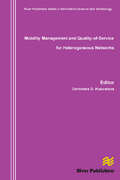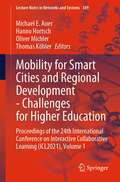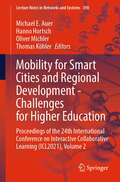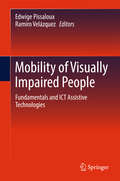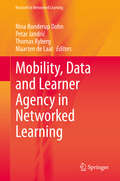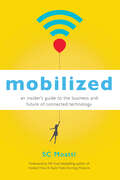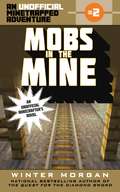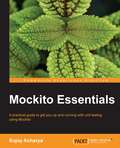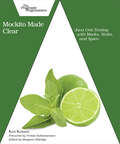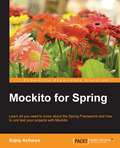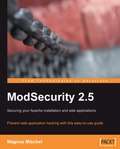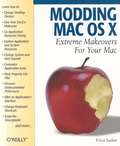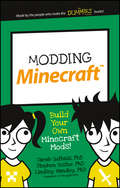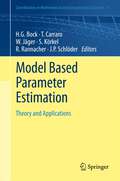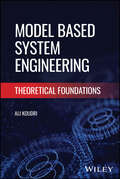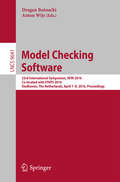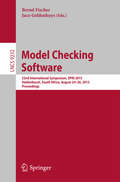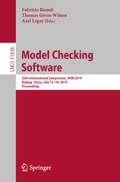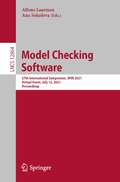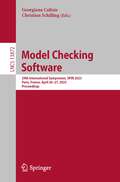- Table View
- List View
Mobility Management and Quality-Of-Service for Heterogeneous Networks (River Publishers Series In Information Science And Technology Ser.)
by Demetres D. KouvatsosConsiderable attention is currently devoted worldwide towards mobility issues and challenges such as those arising from the integration of the next generation Internet over terrestrial digital TV, mobile user location management and multi-service mobile networks subject to quality of service (QoS) routing.This book follows Heterogeneous Networks: Performance Modelling and Analysis, describes recent advances in mobile and wireless networks and the Internet reflecting the state-of-the-art technology and research achievements in mobility management, performance enhancement, optimal admission control and QoS worldwide.Technical topics discussed in the book include• Mobility Management;• Optimal Admission Control;• Performance Modelling Studies;• Access Network Coverage;• Quality of Service (QoS);Heterogeneous Networks: Mobility Management and Quality of Service contains recently extended research papers, which have their roots in the series of the HET-NETs International Working Conferences focusing on the 'Performance Modelling and Evaluation of Heterogeneous Networks' under the auspices of the EU Networks of Excellence Euro-NGI and Euro-FGI.Heterogeneous Networks: Mobility Management and Quality of Service, is ideal for personnel in computer/communication industries as well as academic staff and master/research students in computer science, operational research, electrical engineering and telecommunication systems.ContentsPreface; Participants of the Reviewing Process;• Traffic Modelling and Characterisation;• Queueing and Interconnection Networks;• Performance Evaluation Studies;• TCP Performance Analysis;• Congestion Control;• Application Layer Multicast;• Numerical and Software Tools; Author Index; Keyword Index.
Mobility for Smart Cities and Regional Development - Challenges for Higher Education: Proceedings of the 24th International Conference on Interactive Collaborative Learning (ICL2021), Volume 1 (Lecture Notes in Networks and Systems #389)
by Michael E. Auer Thomas Köhler Hanno Hortsch Oliver MichlerThis book presents recent research on interactive collaborative learning. We are currently witnessing a significant transformation in the development of education and especially post-secondary education. To face these challenges, higher education has to find innovative ways to quickly respond to these new needs. On the one hand, there is a pressure by the new situation in regard to the COVID pandemic. On the other hand, the methods and organizational forms of teaching and learning at higher educational institutions have changed rapidly in recent months. Scientifically based statements as well as excellent experiences (best practice) are absolutely necessary.These were the aims connected with the 24th International Conference on Interactive Collaborative Learning (ICL2021), which was held online by Technische Universität Dresden, Germany, on 22–24 September 2021.Since its beginning in 1998, this conference is devoted to new approaches in learning with a focus on collaborative learning in Higher Education. Nowadays, the ICL conferences are a forum of the exchange of relevant trends and research results as well as the presentation of practical experiences in Learning and Engineering Pedagogy. In this way, we try to bridge the gap between ‘pure’ scientific research and the everyday work of educators.This book contains papers in the fields of Teaching Best Practices Research in Engineering Pedagogy Engineering Pedagogy Education Entrepreneurship in Engineering Education Project-Based Learning Virtual and Augmented Learning Immersive Learning in Healthcare and Medical Education. Interested readership includes policymakers, academics, educators, researchers in pedagogy and learning theory, schoolteachers, learning industry, further and continuing education lecturers, etc
Mobility for Smart Cities and Regional Development - Challenges for Higher Education: Proceedings of the 24th International Conference on Interactive Collaborative Learning (ICL2021), Volume 2 (Lecture Notes in Networks and Systems #390)
by Michael E. Auer Thomas Köhler Hanno Hortsch Oliver MichlerThis book presents recent research on interactive collaborative learning. We are currently witnessing a significant transformation in the development of education and especially post-secondary education. To face these challenges, higher education has to find innovative ways to quickly respond to these new needs. On the one hand, there is a pressure by the new situation in regard to the COVID pandemic. On the other hand, the methods and organizational forms of teaching and learning at higher educational institutions have changed rapidly in recent months. Scientifically based statements as well as excellent experiences (best practice) are absolutely necessary.These were the aims connected with the 24th International Conference on Interactive Collaborative Learning (ICL2021), which was held online by Technische Universität Dresden, Germany, on 22–24 September 2021.Since its beginning in 1998, this conference is devoted to new approaches in learning with a focus on collaborative learning in Higher Education. Nowadays, the ICL conferences are a forum of the exchange of relevant trends and research results as well as the presentation of practical experiences in Learning and Engineering Pedagogy. In this way, we try to bridge the gap between ‘pure’ scientific research and the everyday work of educators.This book contains papers in the fields ofTeaching Best PracticesResearch in Engineering PedagogyEngineering Pedagogy EducationEntrepreneurship in Engineering EducationProject-Based LearningVirtual and Augmented LearningImmersive Learning in Healthcare and Medical Education.Interested readership includes policymakers, academics, educators, researchers in pedagogy and learning theory, schoolteachers, learning industry, further and continuing education lecturers, etc
Mobility of Visually Impaired People
by Edwige Pissaloux Ramiro VelazquezThis book discusses the design of the new mobility assistive information and communication technologies (ICT) devices for the visually impaired. The book begins with a definition of the space concept, followed by the concept of interaction with a space during mobility and this interaction characteristics. The contributors will then examine the neuro-cognitive basis of space perception for mobility and different theories of space perception. The text presents the existing technologies for space perception (sense recovery with stem and iPS cells, implants, brain plasticity, sensory substitution devices, multi modal technologies, etc.), the newest technologies for mobility assistance design, the way the feedback on environment is conveyed to the end-user. Methods for formative and summative evaluations of the mobility devices will also be discussed. The book concludes with a look to the future trends in research and technology development for mobility assistive information and communication technologies. <P><P><i>Advisory: Bookshare has learned that this book offers only partial accessibility. We have kept it in the collection because it is useful for some of our members. Benetech is actively working on projects to improve accessibility issues such as these.</i>
Mobility, Data and Learner Agency in Networked Learning (Research in Networked Learning)
by Thomas Ryberg Maarten De Laat Petar Jandrić Nina Bonderup DohnThe chapters in this book are based on selected peer reviewed research papers presented at the 11th biennial Networked Learning Conference (NLC) 2018 held in Zagreb and were chosen as exemplars of cutting edge research on networked learning. The chapters are organized into three main sections: 1) Aspects of mobility for Networked Learning in a global world, 2) Use and misuse of algorithms and learning analytics, 3) Understanding and empowering learners. The three main sections are flanked by chapters which introduce and reflect on Networked Learning as epistemic practice. The concluding chapter draws out perspectives from the chapters and discusses emerging issues. The book focuses on the nature of learning and interactions as an important characteristic sought out by researchers and practitioners in this field.
Mobilitätswende – autonome Autos erobern unsere Straßen
by Johannes RitzDieses Buch beleuchtet die unterschiedlichen Facetten einer Mobilität mit selbstfahrenden (autonomen) Fahrzeugen. Angefangen bei der Elektromobilität, werden die Parkplatzproblematik, Carsharing und Haftungsfragen unter dem Aspekt einer zunehmenden Verbreitung autonomer Fahrzeuge betrachtet. Auch ökonomische und umweltpolitische Fragen sind aufgeworfen (Ressourcenknappheit, Klimawandel, automatisierte Logistik) und versucht zu beantworten. Können Maschinen moralisch handeln, wie steht es um die Cybersicherheit und den Technikmissbrauch, sind weitere Fragen, die in diesem Buch thematisiert werden.
Mobilized: An Insider’s Guide to the Business and Future of Connected Technology
by SC MoattiMobile has now become such an integral part of how we live that, for many people, losing a cell phone is like losing a limb. Everybody knows mobile is the future, and every business wants in, but what are the elements of mobile success? SC Moatti, a Silicon Valley veteran who was an executive with Facebook, Trulia, and Nokia, gives businesses and professionals simple ways to thrive in this modern day "gold rush." More than a book on technology, this is a book about human nature and what matters most to us. Moatti shows that because mobile products have become extensions of ourselves, we expect from them what we wish for ourselves: an attractive body, a meaningful life, and a growing repertoire of skills. She has created an all-encompassing formula that makes it easy for any business to develop a strategy for creating winning mobile products.Her Body Rule dictates that mobile products must appeal to our sense of beauty—but beauty in a mobile world is both similar to and different from what it means offline. The Spirit Rule says mobile products must help us address our deepest personal needs. And the Mind Rule explains that businesses that want to succeed in mobile need to continually analyze the user experience so they can improve every iteration of their products. Moatti includes case studies from mobile pioneers such as Facebook, Uber, Tinder, WhatsApp, and more. The market is full of how-to books for programming apps, but no works examine what is required for success in the mobile era. Until now.
Mobs in the Mine (The Unofficial Minetrapped Adventure #2)
by Winter MorganLily, Simon, and Michael are still trapped in their Minecraft game, but with new friends and a better understanding of their arch enemy Mr. Anarchy, they’re getting closer to finding a way home. But before they can fight the evil griefer and escape the game, the friends need to replenish their resources-and that means trekking deeper into the Overworld.When their mining party is attacked and hostile mobs reveal surprising new powers, it looks like the end for the trio-and for all their friends in town. Will Lily, Simon, and Michael find a way to defeat the mobs and save their village? Will they ever conquer Mr. Anarchy and escape from the Overworld?Find out in this exciting, action-packed second book in the Unofficial Minetrapped Adventures series by bestselling author Winter Morgan.Sky Pony Press, with our Good Books, Racehorse and Arcade imprints, is proud to publish a broad range of books for young readers-picture books for small children, chapter books, books for middle grade readers, and novels for young adults. Our list includes bestsellers for children who love to play Minecraft; stories told with LEGO bricks; books that teach lessons about tolerance, patience, and the environment, and much more. While not every title we publish becomes a New York Times bestseller or a national bestseller, we are committed to books on subjects that are sometimes overlooked and to authors whose work might not otherwise find a home.
Mockito Cookbook
by Marcin GrzejszczakThis is a focused guide with lots of practical recipes with presentations of business issues and presentation of the whole test of the system. This book shows the use of Mockito's popular unit testing frameworks such as JUnit, PowerMock, TestNG, and so on. If you are a software developer with no testing experience (especially with Mockito) and you want to start using Mockito in the most efficient way then this book is for you. This book assumes that you have a good knowledge level and understanding of Java-based unit testing frameworks.
Mockito Essentials
by Sujoy AcharyaThis book is ideal for developers who have some experience in Java application development as well as some basic knowledge of test doubles and JUnit testing. This book also introduces you to the fundamentals of JUnit testing, test doubles, refactoring legacy code, and writing JUnit tests for GWT and web services.
Mockito Made Clear
by Ken KousenMockito is the most popular framework in the Java world for automating unit testing with dependencies. Learn the Mockito API and how and when to use stubs, mocks, and spies. On a deeper level, discover why the framework does what it does and how it can simplify unit testing in Java. Using Mockito, you'll be able to isolate the code you want to test from the behavior or state of external dependencies without coding details of the dependency. You'll gain insights into the Mockito API, save time when unit testing, and have confidence in your Java programs. If you've only ever run a few JUnit tests or injected stubs into classes to return preset values, it's time to level up your Java toolbox. Dependencies on other classes and external resources can obscure issues and make bugs hard to detect. You need to test classes in isolation to truly pinpoint your problems. And while you could write dummy classes to replace dependencies yourself, Mockito automates the process and helps you fix your code faster. Start with the Mockito API to generate fake classes for dependencies, configure how each should respond when their methods are called, and verify that the class under test interacts with dependencies the way you'd expect. Next, build unit tests with the Mockito framework and feel confident not just that methods are called, but that they are called the correct number of times and in the correct order. Along the way, follow clear test examples based on JUnit 5 to create stubs, mocks, and spies and find the source of any problems lurking in Java classes. Save time, write better code, and have more confidence in your Java programs with Mockito. What You Need: In this book, we use Mockito 4, the latest version of the Mockito framework, but the concepts and the code works on versions 2 and 3. The tests are based on JUnit 5 (known as Jupiter). There are some differences in JUnit 4, but none of those affect Mockito directly. The underlying Java version is 11, but the provided tests in the GitHub repository will work successfully for any version of Java above that (including the current Long Term Support version, 17).
Mockito for Spring
by Sujoy AcharyaIf you are an application developer with some experience in software testing and want to learn more about testing frameworks, then this technology and book is for you. Mockito for Spring will be perfect as your next step towards becoming a competent software tester with Spring and Mockito.
ModSecurity 2.5
by Magnus MischelThis book teaches ModSecurity from the beginning to anyone with basic Linux skills. It starts by focusing on introducing ModSecurity, and explaining the concept of ModSecurity rules and how to write them. Later, it looks at the performance of ModSecurity and what sort of impact ModSecurity has on the speed of your web application. This book is written for system administrators or anyone running an Apache web server who wants to learn how to secure that server. It assumes that you are familiar with using the Linux shell and command-line tools, but does its best to explain everything so that those who are not Linux experts can make full use of ModSecurity.
Modding Mac OS X
by Erica SadunModding Mac OS X isn't about cutting up your Power Mac's case with a saws-all; it's about modifying Mac OS X's user interface and unlocking secrets and dispelling your fears of the Unix command line so you can take command of your Mac. Modding Mac OS X starts out with the very basics of showing you how to configure your Mac and do simple things like change Finder views, use an image from iPhoto's library on your desktop, and how to find and use screen savers. From there, Modding Mac OS X shows you how to: Find hidden features in your favorite applications Dive inside application bundles to find hidden resources Change application and system-wide keyboard shortcuts Work with the Property List Editor to read and edit property list files Wrap your head around the defaults command to tweak an application's settings Hack on NIB files to change an application's interface Control an application with AppleScript, even if it isn't scriptable Each Modding example includes detailed step-by-step instructions that even a novice Mac user can follow, while also providing the necessary detail to satisfy the experienced hacker. The knowledge you gain from tweaking one application can be easily applied to the next. So go on, empower your inner Mac geek. You know you want to.
Modding Minecraft
by Stephen Foster Lindsey Handley Sarah GuthalsMy kid can mod Minecraft? Oh my! There's no doubt about it: Minecraft has taken the world by storm. If your resident Minecraft fanatic is ready to take their experience to a new level of play, introduce them to modding! Modding allows Minecraft players to modify the game through code--giving them the ability to add a variety of gameplay changes, ranging from new blocks and items to new mechanisms to craft. It's pretty much a Minecraft enthusiast's dream brought to life! In Modding Minecraft, your child will be introduced to three fun and easy-to-complete projects that teach them the coding skills to make the most of their love of Minecraft. Walking young readers through projects that outline how to create games in Minecraft for single or multiple players, this friendly and accessible guide takes the intimidation out of coding and instills confidence in children as young as seven as they complete cool coding projects to mod their favorite game. Full-color, eye-popping graphics and a short page count hold their attention while the goal-based format keeps them focused on the task at hand. Before you know it, your kid will be writing their own mods and having even more fun with Minecraft. Kids can complete the projects on their own or alongside an adult Introduces getting started with a single-player, single-level game Moves readers on to multi-level game playing Finishes with a multi-level, multi-player game based on the classic "capture the flag" game With simple and clear instruction that your child can understand, Modding Minecraft is the perfect place for your kid to dig deep and open up a whole new world in their creative play.
Model Based Parameter Estimation: Theory and Applications
by Johannes P. Schlöder Rolf Rannacher Stefan Körkel Thomas Carraro Willi Jäger Hans Georg BockThis judicious selection of articles combines mathematical and numerical methods to apply parameter estimation and optimum experimental design in a range of contexts. These include fields as diverse as biology, medicine, chemistry, environmental physics, image processing and computer vision. The material chosen was presented at a multidisciplinary workshop on parameter estimation held in 2009 in Heidelberg. The contributions show how indispensable efficient methods of applied mathematics and computer-based modeling can be to enhancing the quality of interdisciplinary research. The use of scientific computing to model, simulate, and optimize complex processes has become a standard methodology in many scientific fields, as well as in industry. Demonstrating that the use of state-of-the-art optimization techniques in a number of research areas has much potential for improvement, this book provides advanced numerical methods and the very latest results for the applications under consideration.
Model Based System Engineering: Theoretical Foundations
by Ali KoudriWell-structured and interdisciplinary overview of MBSE, covering both theoretical foundations and practical applications Taking an interdisciplinary approach, Model Based System Engineering provides a comprehensive introduction to understanding and applying model-based system engineering (MBSE) principles and practices in the design, development, and management of complex systems. Throughout the book, readers will find case studies, practical examples and exercises, and multiple-choice questions that reinforce key concepts and promote active learning. The book begins by exploring the historical context of MBSE, highlighting its emergence as a response to the limitations of traditional document-centric approaches. It emphasizes the crucial role of abstraction in MBSE and introduces key concepts, definitions, and taxonomies that form the bedrock of this discipline. Subsequent chapters delve into the core principles of modeling, examining the intricate relationships between systems, languages, and models. Sample topics covered in Model Based System Engineering include: Prefaced by Bran Selic, a world authority on MBSE and software engineering Model verification and validation, exploring various techniques, such as model checking, simulation, and testing that enable the early detection and resolution of design errors and inconsistencies Model-based system architecting, methodological considerations, and application in real-world contexts Various modeling paradigms, including structural and behavioral models The pivotal role of languages in enabling effective modeling practices Benefits of formalization in enhancing the precision, consistency, and analyzability of system models Model Based System Engineering is an essential resource for systems engineers, researchers, and students seeking to understand and harness the power of MBSE in tackling the complexities of modern systems.
Model Checking Quantum Systems: Principles and Algorithms
by Yuan Feng Mingsheng YingModel checking is one of the most successful verification techniques and has been widely adopted in traditional computing and communication hardware and software industries. This book provides the first systematic introduction to model checking techniques applicable to quantum systems, with broad potential applications in the emerging industry of quantum computing and quantum communication as well as quantum physics. Suitable for use as a course textbook and for self-study, graduate and senior undergraduate students will appreciate the step-by-step explanations and the exercises included. Researchers and engineers in the related fields can further develop these techniques in their own work, with the final chapter outlining potential future applications.
Model Checking Software
by Dragan Bošnački Anton WijsThis bookconstitutes the refereed proceedings of the 23rd International Symposium on ModelChecking Software, SPIN 2016, held in Eindhoven, The Netherlands, in April 2016. The 16 papers presented, consisting of 11 regular papers, 1 idea paper, and 4tool demonstrations, were carefully reviewed and selected from 27 submissions. Topics covered include model checking techniques, model checking tools, concurrent system semantics, equivalence checking, temporal logics, probabilistic systems, schedule and strategy synthesis using model checking, and verification case studies.
Model Checking Software
by Bernd Fischer Jaco GeldenhuysThis book constitutes the refereed proceedings of the 22nd International Symposium on Model Checking Software, SPIN 2015, held in Stellenbosch, South Africa, in August 2015. The 18 papers presented - 14 regular papers and 4 tool or new idea papers - were carefully reviewed and selected from 27 submissions. They cover the field between theoretical advances and practical considerations and are organized in topical sections such as abstraction, refinement, translation; Büchi automata and hashing; embedded systems; heuristics and benchmarks; SAT/SMT- based approaches; software validation and verification.
Model Checking Software: 25th International Symposium, SPIN 2018, Malaga, Spain, June 20-22, 2018, Proceedings (Lecture Notes in Computer Science #10869)
by Pedro Merino María Del GallardoThis book constitutes the refereed proceedings of the 25th International Symposium on Model Checking Software, SPIN 2018, held in Malaga, Spain, in June 2018.The 14 papers presented, 1 short paper, and 1 demo-tool paper, were carefully reviewed and selected from 28 submissions. Topics covered include formal verification techniques for automated analysis of software; formal analysis for modeling languages, such as UML/state charts; formal specification languages, temporal logic, design-by-contract; model checking, automated theorem proving, including SAT and SMT; verifying compilers; abstraction and symbolic execution techniques; and much more.
Model Checking Software: 26th International Symposium, SPIN 2019, Beijing, China, July 15–16, 2019, Proceedings (Lecture Notes in Computer Science #11636)
by Axel Legay Fabrizio Biondi Thomas Given-WilsonThis book constitutes the refereed proceedings of the 26th International Symposium on Model Checking Software, SPIN 2019, held in Beijing, China, in July 2019. The 11 full papers presented and 2 demo-tool papers, were carefully reviewed and selected from 29 submissions. Topics covered include formal verification techniques for automated analysis of software; formal analysis for modeling languages, such as UML/state charts; formal specification languages, temporal logic, design-by-contract; model checking, automated theorem proving, including SAT and SMT; verifying compilers; abstraction and symbolic execution techniques; and much more.
Model Checking Software: 27th International Symposium, SPIN 2021, Virtual Event, July 12, 2021, Proceedings (Lecture Notes in Computer Science #12864)
by Ana Sokolova Alfons LaarmanThis book constitutes the refereed proceedings of the 27th International Symposium on Model Checking Software, SPIN 2021, held virtually in July 2021.The 3 full papers, 4 tool papers, and 1 case study presented together with 2 invited talks were carefully reviewed and selected from 20 submissions. Topics covered include formal verification techniques for automated analysis of software; formal analysis for modeling languages, such as UML/state charts; formal specification languages, temporal logic, design-by-contract; model checking, automated theorem proving, including SAT and SMT; verifying compilers; abstraction and symbolic execution techniques; and much more.
Model Checking Software: 28th International Symposium, SPIN 2022, Virtual Event, May 21, 2022, Proceedings (Lecture Notes in Computer Science #13255)
by Grigore Rosu Owolabi LegunsenThis book constitutes the refereed proceedings of the 28th International Symposium on Model Checking Software, SPIN 2022, held virtually in May 2022.The 8 full papers were carefully reviewed and selected from 11 submissions. Topics covered include formal verification techniques for automated analysis of software; formal analysis for modeling languages, such as UML/state charts; formal specification languages, temporal logic, design-by-contract; model checking, automated theorem proving, including SAT and SMT; verifying compilers; abstraction and symbolic execution techniques; and much more.
Model Checking Software: 29th International Symposium, SPIN 2023, Paris, France, April 26–27, 2023, Proceedings (Lecture Notes in Computer Science #13872)
by Georgiana Caltais Christian SchillingThis book constitutes the refereed proceedings of the 29th International Symposium on Model Checking Software, SPIN 2023, held in Paris, France, during April 26–27, 2023. The 9 full papers and 2 short papers included in this book were carefully reviewed and selected from 21 submissions. They were organized in topical sections as follows: binary decision diagrams, concurrency, testing, synthesis, explicit-state model checking.
